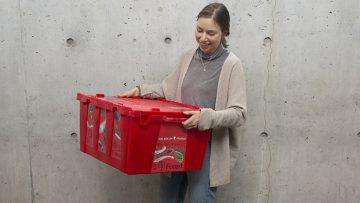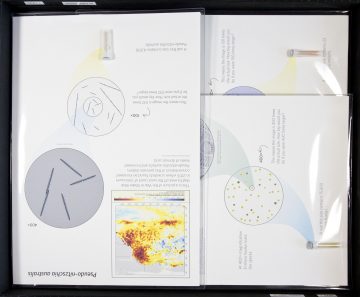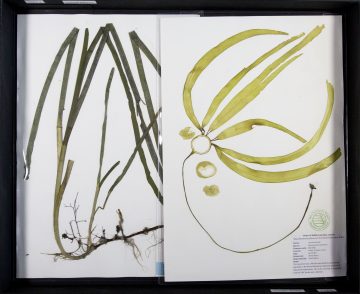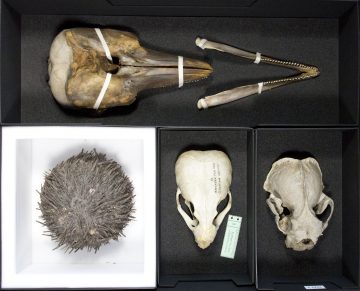
The theme for this Beaty Box is the interconnectedness of marine organisms and the impact of climate change. Under this theme, students will use critical thinking and problem solving skills to learn more about:
- The relationships between the littlest and largest creatures in the ocean
- The impact of extinction and climate change on marine food webs
- The role of sustainable practices in shaping the future of the ocean
By the end of the lesson, your group should feel more comfortable describing the relationships between organisms and the way they are impacted by climate change.
Request a Marine Life Box for your classroom here.
How to pack your Marine Life Beaty Box
Please note there are two Marine Life Boxes available, but each box has the same contents. “Marine Life 009” and “Marine Life 010” contain the same specimens but may be organized differently.
Click here for a video on how to handle Beaty Box specimens.
Marine Life Box Dimensions:
- Length: 60.9 cm (24”)
- Width: 50 cm (19.5”)
- Height: 33 cm (13”)
- Weight: 10.64 kg (23.46 lbs.)

- Box 009 Tray 1
- Box 009 Tray 1
- Box 009 Tray 2
Lesson Plan: Ocean Life, Little and Large
Learning Objectives: After this lesson, students should be able to:
- Understand the complexity of ecosystem dynamics.
- Have a working understanding of climate change, its impacts on ecosystems and consequences to humans.
- Discuss sustainable practices mitigate the effects of climate change on the ocean.
Curriculum Links
- Grade 2: Water is essential to all living things, and it cycles through the environment.
- Grade 3: Living things are diverse, can be grouped, and interact in their ecosystems.
- Grade 5: First Peoples concepts of interconnectedness in the environment; the nature of sustainable practices around BC’s resources; First Peoples knowledge of sustainable practices.
- Grade 7: Earth and its climate have changed over geological time.
- Grade 9: The biosphere, geosphere, hydrosphere, and atmosphere are interconnected, as matter cycles and energy flows through them; sustainability of systems; First Peoples knowledge of interconnectedness and sustainability.
- Grade 10: Acid-base chemistry.
- Chemistry 11: Organic chemistry and its applications have significant implications for human health, society, and the environment.
- Earth Sciences 11: The transfer of energy through the atmosphere creates weather, and this transfer is affected by climate change; the distribution of water has a major influence on weather and climate.
- Environmental Science 11: The distribution of water has a major influence on weather and climate; Complex roles and relationships contribute to diversity of ecosystems; Humans can play a role in stewardship and restoration of ecosystems.
- Science for Citizens 11: Scientific understanding enables humans to respond and adapt to changes locally and globally; Scientific processes and knowledge inform our decisions and impact our daily lives; evidence-based decision making through science.
- Geology 12: The plate tectonic theory explains the changes that occur within Earth and to Earth’s crust throughout geological time.
- Chemistry 12: Acid or base strength depends on the degree of ion dissociation.
- Environmental Science 12: Human activities cause changes in the global climate system; Living sustainably supports the well-being of self, community, and Earth; Human actions affect the quality of water and its ability to sustain life; Sustainable land use is essential to meet the needs of a growing
Educators Manual
- Each box comes with a comprehensive Educator Manual to provide you with all the information you need to confidently share and explore the Marine Life Beaty Box with your group.
- Manual includes:
- Beaty Box Basics
- Information on the specimens in the box - where they come from, how they are prepared, and information on how to handle them safely
- Information about the Beaty Biodiversity Museum
- Click here to download Beaty Box Basics
- Customized Lesson Plan and Specimen Information
- A lesson plan and list of relevant "Big Ideas" and "Core Concepts" outlined in the BC Curriculum
- Flashcards for each specimen with images and background information
- Suggestions and links to additional activities
- A USB key with a digital copy of the manual plus extra images and activities you can print off or download
- Click here to download the Marine Life Box Lesson Plan and Specimen Information
- Beaty Box Basics





